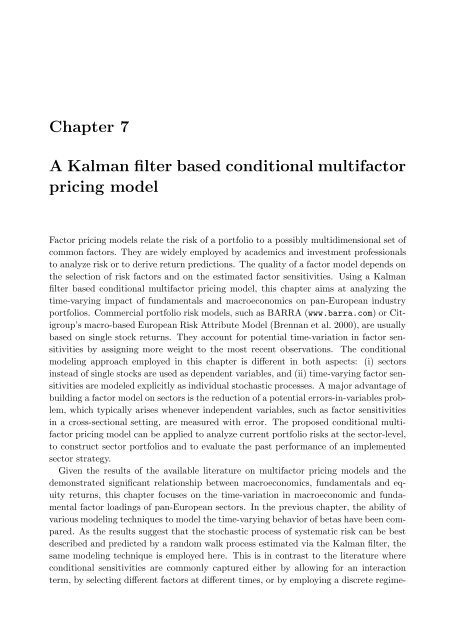Applications of state space models in finance
Applications of state space models in finance
Applications of state space models in finance
Create successful ePaper yourself
Turn your PDF publications into a flip-book with our unique Google optimized e-Paper software.
Chapter 7<br />
A Kalman filter based conditional multifactor<br />
pric<strong>in</strong>g model<br />
Factor pric<strong>in</strong>g <strong>models</strong> relate the risk <strong>of</strong> a portfolio to a possibly multidimensional set <strong>of</strong><br />
common factors. They are widely employed by academics and <strong>in</strong>vestment pr<strong>of</strong>essionals<br />
to analyze risk or to derive return predictions. The quality <strong>of</strong> a factor model depends on<br />
the selection <strong>of</strong> risk factors and on the estimated factor sensitivities. Us<strong>in</strong>g a Kalman<br />
filter based conditional multifactor pric<strong>in</strong>g model, this chapter aims at analyz<strong>in</strong>g the<br />
time-vary<strong>in</strong>g impact <strong>of</strong> fundamentals and macroeconomics on pan-European <strong>in</strong>dustry<br />
portfolios. Commercial portfolio risk <strong>models</strong>, such as BARRA (www.barra.com) or Citigroup’s<br />
macro-based European Risk Attribute Model (Brennan et al. 2000), are usually<br />
based on s<strong>in</strong>gle stock returns. They account for potential time-variation <strong>in</strong> factor sensitivities<br />
by assign<strong>in</strong>g more weight to the most recent observations. The conditional<br />
model<strong>in</strong>g approach employed <strong>in</strong> this chapter is different <strong>in</strong> both aspects: (i) sectors<br />
<strong>in</strong>stead <strong>of</strong> s<strong>in</strong>gle stocks are used as dependent variables, and (ii) time-vary<strong>in</strong>g factor sensitivities<br />
are modeled explicitly as <strong>in</strong>dividual stochastic processes. A major advantage <strong>of</strong><br />
build<strong>in</strong>g a factor model on sectors is the reduction <strong>of</strong> a potential errors-<strong>in</strong>-variables problem,<br />
which typically arises whenever <strong>in</strong>dependent variables, such as factor sensitivities<br />
<strong>in</strong> a cross-sectional sett<strong>in</strong>g, are measured with error. The proposed conditional multifactor<br />
pric<strong>in</strong>g model can be applied to analyze current portfolio risks at the sector-level,<br />
to construct sector portfolios and to evaluate the past performance <strong>of</strong> an implemented<br />
sector strategy.<br />
Given the results <strong>of</strong> the available literature on multifactor pric<strong>in</strong>g <strong>models</strong> and the<br />
demonstrated significant relationship between macroeconomics, fundamentals and equity<br />
returns, this chapter focuses on the time-variation <strong>in</strong> macroeconomic and fundamental<br />
factor load<strong>in</strong>gs <strong>of</strong> pan-European sectors. In the previous chapter, the ability <strong>of</strong><br />
various model<strong>in</strong>g techniques to model the time-vary<strong>in</strong>g behavior <strong>of</strong> betas have been compared.<br />
As the results suggest that the stochastic process <strong>of</strong> systematic risk can be best<br />
described and predicted by a random walk process estimated via the Kalman filter, the<br />
same model<strong>in</strong>g technique is employed here. This is <strong>in</strong> contrast to the literature where<br />
conditional sensitivities are commonly captured either by allow<strong>in</strong>g for an <strong>in</strong>teraction<br />
term, by select<strong>in</strong>g different factors at different times, or by employ<strong>in</strong>g a discrete regime-

















